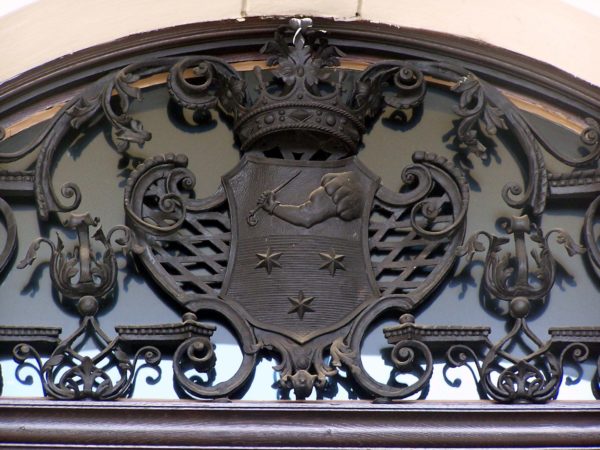
Coat of arms of the Barons Ritter-Záhony in Velenje
VELENJE, VILLA HERBERSTEIN
Location of the coat of arms: portal
The façade above the entrance to Herberstein Villa in Velenje displays a black metal coat of arms, commonly associated with the last prewar owners of the villa, the Counts von Herberstein. However, the arms in fact belonged to a much more recent family that built the villa at the end of the nineteenth century—the Barons Ritter-Záhony, who left a much deeper mark on Gorizia (Germ. Görz) than Velenje.
The Ritter family originated in Frankfurt, where one can trace individual members since as early as the sixteenth century. The family’s social climb began in the early nineteenth century, spearheaded by the industrious Johann Christoph Ritter (1782–1838), who first acquired his trade and entrepreneurial experience in England until about 1809, when he arrived in Austrian Trieste, where he traded in saltpeter from Malta, a key and highly sought-after substance used in the production of gunpowder during the war with France. In 1809, saltpeter (and a bit of luck) secured the initial capital for the enterprising Johann Christoph, after he managed to navigate his ship loaded with this cargo out of the grasp of the French, who had just occupied Trieste, and then sold it for a high price to the Austrian army. After the Napoleonic Wars, he settled in Trieste, where he purchased a sugar refinery, and in 1819 he transferred it to Gorizia, which became the Ritters’ business center. In 1830, Emperor Franz I as King of Hungary raised Johann Christoph to the rank of Hungarian nobility and granted him the chamber seigniory of Záhony in what is now northeastern Hungary. In the form of a noble predicate, the seigniory became part of the family name: Ritter von Záhony.
In two marriages, Johann Christoph fathered fourteen children, including as many as nine sons. The most industrious among them was perhaps Julius Hector (1816–1878), who inherited the sugar refinery and expanded the family property further by purchasing various industrial plants in Gorizia and its surroundings, whereas one of his oldest sons, Alfred (1839–1865), or his descendants carried the name Ritter-Záhony to Velenje. Alfred died at the very young age of twenty-six. His marriage with Maria Baroness von Steininger produced his daughter Giselle and son Alfred Jr. Giselle’s marriage to the castellan of Velenje, Karl von Adamovich, in 1886 may have led her mother to purchase several landed estates near Velenje Castle that same year. In the following years (1886–1887), she built a villa designed by the architect Otto Hieser and named it Villa Ritter. In 1890, she sold it to her son, Alfred Jr., who sold it to Josef von Eder eight years later. The villa thus only remained in the hands of its original owners for a little more than a decade and was renamed Novi Šalek (Germ. Neu Schallegg) under Eder. Today, it is called Herberstein Villa after its last prewar owner, Maria Anna Countess von Herberstein.
Despite having passed through various owners and names, the villa still unequivocally demonstrates its Ritter-Záhony origin with the coat of arms above the entrance. Nonetheless, rather than a uniform coat of arms, the Ritter-Záhony family had several versions of it. The original coat of arms, which the Ritters are believed to have brought from Frankfurt, merely contained a cloud and a hand stretching out from it, holding a shepherd’s crook. Upon Johann Christoph’s ennoblement in 1830, the escutcheon was divided, with the original coat of arms remaining in the upper half and the lower blue half featuring a silver sailing ship on a choppy sea, turned to the sinister side and representing the “saltpeter battle” in Trieste from 1809. The coat of arms was also used by all Johann Christoph’s sons until a few of them introduced slight variations of it. When, for example, Julius Hector obtained the knightly title for himself and his descendants in 1855 and the baronial title in 1869, his coat of arms also changed: in the lower half, the sailing ship was replaced by three golden stars in a 2:1 ratio, which also allegedly originated from some earlier Ritter arms. Such a coat of arms was also depicted on the villa in Velenje, built by Julius Hector’s descendants.
Sources:
Janežič, Špela: Vila in posestvo Herberstein v Velenju (diploma thesis). Maribor, 2003, pp. 2, 18–22, 126.
Ritter von Záhony, Eugen: Chronik und Stammbaum der im Jahre 1829 in Österreich mit dem Prädikat “von Záhony” geadelten Familie Ritter aus Frankfurt a. M. Monastero bei Aquileja, 1915.
